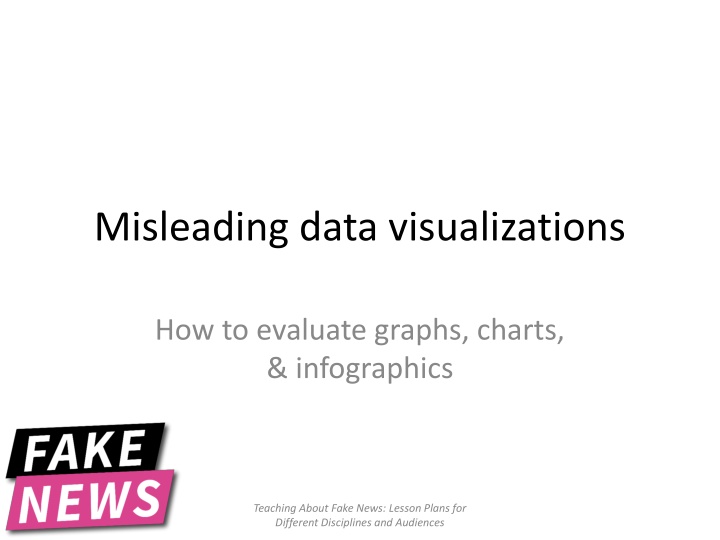
Evaluating Misleading Data Visualizations and Teaching About Fake News
Explore how to evaluate graphs, charts, and infographics to identify misleading data visualizations. Discover lesson plans for different disciplines about fake news. Learn about the impact of data in our daily lives and the non-neutrality of data and visualizations. Understand how data can be misused and manipulated through inappropriate methods, incorrect analysis, selection bias, figure design, spatial issues, and more. Enhance your understanding of ethical design choices to combat misinformation.
Download Presentation

Please find below an Image/Link to download the presentation.
The content on the website is provided AS IS for your information and personal use only. It may not be sold, licensed, or shared on other websites without obtaining consent from the author. If you encounter any issues during the download, it is possible that the publisher has removed the file from their server.
You are allowed to download the files provided on this website for personal or commercial use, subject to the condition that they are used lawfully. All files are the property of their respective owners.
The content on the website is provided AS IS for your information and personal use only. It may not be sold, licensed, or shared on other websites without obtaining consent from the author.
E N D
Presentation Transcript
Misleading data visualizations How to evaluate graphs, charts, & infographics Teaching About Fake News: Lesson Plans for Different Disciplines and Audiences
Data in our daily lives Image sources: https://www.ncdc.noaa.gov/sotc/global/201908 https://commons.wikimedia.org/wiki/File:Celebrate_Men %27s_Health_Month_Infographic.jpg Search the ACRL Sandbox for more lessons with #fakenews
Data and data visualizations are not neutral Search the ACRL Sandbox for more lessons with #fakenews
How data can be used to mislead Data collection & analysis: o Inappropriate data collection methods o Inappropriate or incorrect analysis o Correlation vs causation Image source: https://www.tylervigen.com/spurious-correlations Search the ACRL Sandbox for more lessons with #fakenews
How data can be used to mislead Data selection & figure design: o Highlighting outliers o Obscuring outliers VS Graphs source: Tom Hopper: https://tomhopper.me/2010/08/30/ graphing-highly-skewed-data/ Search the ACRL Sandbox for more lessons with #fakenews
How data can be used to mislead Spatial & pictorial issues: Lie factor Size of the difference in the visualization Lie factor = Size of the difference in the data Image source: https://eagereyes.org/blog/2008/ny-times- the-best-and-worst-of-data-visualization Search the ACRL Sandbox for more lessons with #fakenews
How data can be used to mislead Trouble with axes VS Image source: Media Matters for America: http://mediamatters.org/research/2012/10/01/a- history-of-dishonest-fox-charts/190225 Search the ACRL Sandbox for more lessons with #fakenews
Activity List out design choices Suggest more transparent/ethical design choices Image source: New York Times: https://well.blogs.nytimes.com/2012/02/02/the-kids- are-more-than-all-right/ Search the ACRL Sandbox for more lessons with #fakenews
